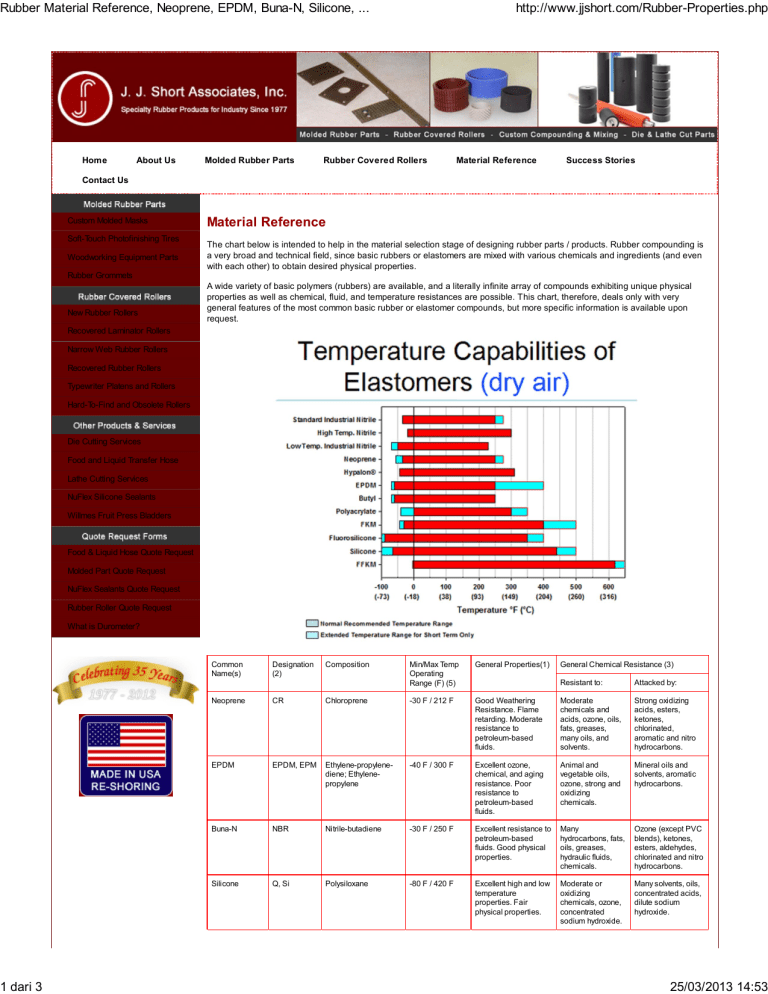Rubber Material Properties Chart: Neoprene, EPDM, Buna-N, Silicone
advertisement

Rubber Material Reference, Neoprene, EPDM, Buna-N, Silicone, ... 1 dari 3 Home About Us Molded Rubber Parts http://www.jjshort.com/Rubber-Properties.php Rubber Covered Rollers Material Reference Success Stories Contact Us Custom Molded Masks Soft-Touch Photofinishing Tires Woodworking Equipment Parts Material Reference The chart below is intended to help in the material selection stage of designing rubber parts / products. Rubber compounding is a very broad and technical field, since basic rubbers or elastomers are mixed with various chemicals and ingredients (and even with each other) to obtain desired physical properties. Rubber Grommets New Rubber Rollers A wide variety of basic polymers (rubbers) are available, and a literally infinite array of compounds exhibiting unique physical properties as well as chemical, fluid, and temperature resistances are possible. This chart, therefore, deals only with very general features of the most common basic rubber or elastomer compounds, but more specific information is available upon request. Recovered Laminator Rollers Narrow Web Rubber Rollers Recovered Rubber Rollers Typewriter Platens and Rollers Hard-To-Find and Obsolete Rollers Die Cutting Services Food and Liquid Transfer Hose Lathe Cutting Services NuFlex Silicone Sealants Willmes Fruit Press Bladders Food & Liquid Hose Quote Request Molded Part Quote Request NuFlex Sealants Quote Request Rubber Roller Quote Request What is Durometer? Common Name(s) Designation (2) Composition Min/Max Temp Operating Range (F) (5) General Properties(1) General Chemical Resistance (3) Resistant to: Attacked by: Neoprene CR Chloroprene -30 F / 212 F Good Weathering Resistance. Flame retarding. Moderate resistance to petroleum-based fluids. Moderate chemicals and acids, ozone, oils, fats, greases, many oils, and solvents. Strong oxidizing acids, esters, ketones, chlorinated, aromatic and nitro hydrocarbons. EPDM EPDM, EPM Ethylene-propylenediene; Ethylenepropylene -40 F / 300 F Excellent ozone, chemical, and aging resistance. Poor resistance to petroleum-based fluids. Animal and vegetable oils, ozone, strong and oxidizing chemicals. Mineral oils and solvents, aromatic hydrocarbons. Buna-N NBR Nitrile-butadiene -30 F / 250 F Excellent resistance to petroleum-based fluids. Good physical properties. Many hydrocarbons, fats, oils, greases, hydraulic fluids, chemicals. Ozone (except PVC blends), ketones, esters, aldehydes, chlorinated and nitro hydrocarbons. Silicone Q, Si Polysiloxane -80 F / 420 F Excellent high and low temperature properties. Fair physical properties. Moderate or oxidizing chemicals, ozone, concentrated sodium hydroxide. Many solvents, oils, concentrated acids, dilute sodium hydroxide. 25/03/2013 14:53 Rubber Material Reference, Neoprene, EPDM, Buna-N, Silicone, ... 2 dari 3 http://www.jjshort.com/Rubber-Properties.php SBR SBR Styrene-butadiene -20 F / 212F Good physical properties and abrasion resistance. Poor resistance to petroleum-based fluids. Most moderate chemicals, wet or dry, organic acids, alcohols, ketones, aldehydes. Ozone, strong acids, fats, oils, greases, most hydrocarbons. Butyl IIR Isobutene-isoprene -60 F / 250 F Very good weathering resistance. Excellent dielectric properties. Low permeability to air. Good physical properties. Poor resistance to petroleum-based fluids. Animal and vegetable fats, oils, greases, ozone, strong and oxidizing chemicals. Petroleum, solvents, coal tar solvents, aromatic hydrocarbons. Natural, Gum Rubber NR Isoprene, natural -60 F / 220 F Excellent physical properties including abrasion and low temperature resistance. Poor resistance to petroleum-based fluids. Most moderate chemicals, wet or dry, organic acids, alcohols, ketones, aldehydes. Ozone, strong acids, fats, oils, greases, most hydrocarbons. Hypalon (4) CSM Chloro-sulfonylpolyethylene -40 F / 320 F Excellent ozone, weathering, and acid resistance. Good and abrasion and heat resistance. Fair resistance to petroleum-based fluids. Similar to Neoprene with improved acid resistance. Concentrated oxidizing acids, esters, ketones, chlorinated, aromatic, and nitro hydrocarbons. Urethane AU, EU Polyethylene-apdate, Poly (oxy-1, 4, butylene) ether -40 F / 175 F Good aging and excellent abrasion, tear, and solvent resistance. Poor high temperature properties. Ozone, hydrocarbons, moderate chemicals, fats, oils, greases. Concentrated acids, ketones, esters, chlorinated and nitro hydrocarbons. Viton ® (4), Fluoroelastomer FPM Hexaflouropropylenevinylidene fluoride - 10 F / 400 F Excellent oil and air resistance both at low and high temperatures. Very good chemical resistance. All aliphatic, aromatic and halogenated hydrocarbons, acids, animal and vegetable oils. Ketones, low molecular weight esters and nitro containing compounds. Fluoro-silicone FSi Fluorocarbon -60 F / 350 F Offers superior heat resistance. resistant to cold, oils and solvents of fluorinated rubber. Good for special applications where general resistance to oxidizing chemicals, aromatic and chlorinated solvent bases are required. Narrower Temp range than silicone but better fluid resistance Moderate or oxidizing chemicals, ozone, aromatic chlorinated solvents, bases. Brake fluids, hydrazine, ketones. Hydrogenated Nitrile HNBR Hydrogenated Acrylonitrile-butadiene rubber -22 F / 300 F Excellent heat and oil resistance, improved fuel and ozone resistance (approximately 5X) over Nitrile Good abrasion resistance. Decreased elasticity at low temperatures with hydrogenation over standard nitrile. Many hydrocarbons, transmission fluids, refrigerants, diluted acids, hydraulic fluids, silicone oils, vegetable and animal fats and oils, water and steam. Chlorated hydrocarbons, keytones, strong acids. Carboxylated Nitrile XNBR Carboxylated Nitrile -20 F / 250 F Excellent Abrasion and Tear Resistance, Fair Ozone and Steam Resistance. Poor to Fair Sunlight and Outdoors. Good to Excellent Oil Resistance. Many hydrocarbons, fats, oils, greases, hydraulic fluids, chemicals. Ozone (except PVC blends), ketones, esters, aldehydes, chlorinated and nitro hydrocarbons. Footnotes 1. From the "Sheet Rubber Handbook - Gasket and Packing Materials" publication #IP-40 of the Rubber Manufacturers Association (RMA). 2. ASTM D 1418-79 3. 1979 Yearbook of the Los Angeles Rubber Group, Inc. 4. "Viton" and "Kalrez" are registered trademarks of E.I. Dupont, Inc. 5. The temperature range is determined by the base elastomer used. This chart depicts the maximum temperature range 25/03/2013 14:53 Rubber Material Reference, Neoprene, EPDM, Buna-N, Silicone, ... 3 dari 3 http://www.jjshort.com/Rubber-Properties.php for each elastomer. The temperature range for a specific compound may not reach these maximum limits. Higher temperatures may be considered if exposure is short or intermittent. If it’s made from rubber, contact us! Copyright 2008-2013 - J.J. Short Associates, Inc - All Rights Reserved Developed by Orlando Web Services 25/03/2013 14:53



